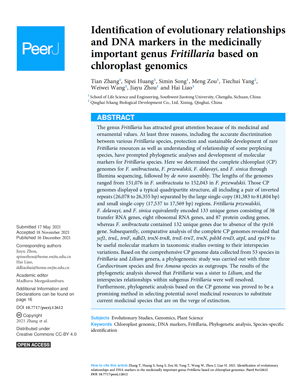NEWS 2021
Identification of evolutionary relationships and DNA markers in the medicinally important genus Fritillaria based on chloroplast genomics
Tian ZHANG1, Sipei HUANG1, Simin SONG1, Meng ZOU1, Tiechui YANG2, Weiwei WANG1, Jiayu ZHOU1, Hai LIAO1
PeerJ 9:e12612 (2021)
https://doi.org/10.7717/peerj.12612
1School of Life Science and Engineering, Southwest Jiaotong University, Chengdu, Sichuan, China
2Qinghai lvkang Biological Development Co., Ltd, Xining, Qinghai, China
Abstract
The genus Fritillaria has attracted great attention because of its medicinal and ornamental values. At least three reasons, including the accurate discrimination between various Fritillaria species, protection and sustainable development of rare Fritillaria resources as well as understanding of relationship of some perplexing species, have prompted phylogenetic analyses and development of molecular markers for Fritillaria species. Here we determined the complete chloroplast (CP) genomes for F. unibracteata, F. przewalskii, F. delavayi, and F. sinica through Illumina sequencing, followed by de novo assembly. The lengths of the genomes ranged from 151,076 in F. unibracteata to 152,043 in F. przewalskii. Those CP genomes displayed a typical quadripartite structure, all including a pair of inverted repeats (26,078 to 26,355 bp) separated by the large single-copy (81,383 to 81,804 bp) and small single-copy (17,537 to 17,569 bp) regions. Fritillaria przewalskii, F. delavayi, and F. sinica equivalently encoded 133 unique genes consisting of 38 transfer RNA genes, eight ribosomal RNA genes, and 87 protein coding genes, whereas F. unibracteata contained 132 unique genes due to absence of the rps16 gene. Subsequently, comparative analysis of the complete CP genomes revealed that ycf1, trnL, trnF, ndhD, trnN-trnR, trnE-trnT, trnN, psbM-trnD, atpI, and rps19 to be useful molecular markers in taxonomic studies owning to their interspecies variations. Based on the comprehensive CP genome data collected from 53 species in Fritillaria and Lilium genera, a phylogenomic study was carried out with three Cardiocrinum species and five Amana species as outgroups. The results of the phylogenetic analysis showed that Fritillaria was a sister to Lilium, and the interspecies relationships within subgenus Fritillaria were well resolved. Furthermore, phylogenetic analysis based on the CP genome was proved to be a promising method in selecting potential novel medicinal resources to substitute current medicinal species that are on the verge of extinction.




